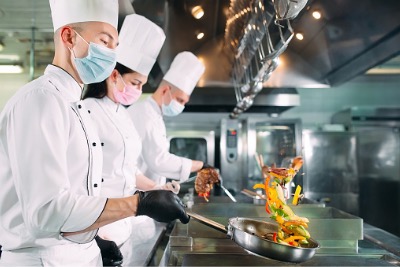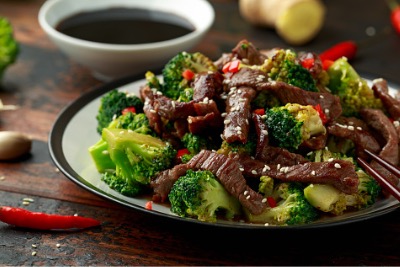
Today’s Beef Consumer Part 2 - Foodservice
In part one last week, we reviewed the National Beef Cattlemen’s Association (NCBA) report on what the beef consumer prefers, what they want and what they are planning to buy in the future. Now, lets take a look at how inflation is affecting tastes, preferences and plans in the foodservice sector.
The NBCA’s surveys on consumer trends, preferences and behaviors show that cost is now more important than convenience. Inflation and price have become increasingly important considerations as US Government pandemic incentives and SNAP payments have either declined or have ended altogether. For some consumers that is affecting the decision of whether to buy food online - particularly if there is a delivery fee.
Future consumer intentions to order food online from restaurants have also tapered down by more than 10% in 2022. According to the latest survey, DoorDash is still the platform of choice for almost 50% of consumers and then UberEats, followed by restaurant specific apps and Grubhub.

In their surveys, the NBCA asked about overall shopping and dining habits over the next six months. What they found was that consumers still want to go to restaurants, but they are looking for deals. They understand that prices are increasing due to inflation, but there are limits to their willingness to pay higher prices. Consumers are likely to look for discounts. They are using coupons more often, ordering take-out, and dining out less often than in pre-pandemic 2020. About half say that they are using more coupons for restaurants and that often, the availability of a coupon is the deciding factor on where to eat or order from.
Still the number one predicter of restaurant of choice remains the taste of the food. No change there. At restaurants, taste of food is by far the most important attribute or driver of consumer demand.
How do restaurant consumers rank beef versus chicken?
Restaurant patrons rank beef as their #1 choice of meat at restaurants. About 50% more people chose it as their number one choice over the runner up, chicken. Consumers generally perceive chicken as a healthier choice. When asked about healthy choices, chicken tends to hold the high ground.
About 64% of respondents said they plan to eat out in the future and not change their consumption habits. And about 15% said that they would eat out less often.

Convenience Versatility Price
Since Jan 2022 the NBCA has tracked take-out food overall and then compare that figure to food that is purchased at markets and prepared at home. Take-out food has traditionally remained steady, but in January of 2022 it began to decline slightly.
Beef has seen a decrease in the inflation rate. From a consumer perspective, the slowing down of the price increases is a good thing. While the price increase of beef has slowed down , the actual price has not declined. When compared it to other proteins, such as poultry and eggs, the increase in beef prices is slowing down at a higher rate. From a historical view, consumption of beef declined between 2021 and 2022, but it is still at its highest level since 1988. Beef demand is remaining strong and that has a big impact on price levels
Foodservice Projected Growth
It's no surprise that in foodservice venues, beef sales declined during the pandemic. But what is surprising is that despite the increase in price, sales of foodservice beef are back at the 2020 levels. The increase is both in dollar sales and in number of pounds consumed. And both sales and quantity of beef consumed in foodservice establishments are projected to grow.

Projected finalized beef sales at different types of foodservice venues are expected to be the strongest at restaurants. With the strongest growth in both quick service (fast food) and full service (casual and fine dining). They are also expected to be strong at educational institutions, with a steady projected rise in sales until 2027.
Consumer Demand, Preferences and Behavior
Consumers say they want the convenience factor of quick service. They value the lower prices, quick service, and tasty meals. They also value nutritional benefits but are willing to forgo healthy options for a combination of convenience, price and taste. Beef is projected to continue to outpace chicken in terms dollar sales is for all foodservice venues. Beef is currently nearly half of food service sales for protein. With chicken being in second place and pork third. In terms of pounds consumed at food service venues, chicken is #1. Beef is a higher price point, so it accounts for more in sales.
Despite the continuing strong demand for beef dishes at restaurants, consumers said that they would be ordering more ground beef dishes at restaurants, and they will decrease their consumption of steaks and more expensive cuts of beef. Given the current economic climate, it is not surprising that consumers are seeking value for money. Beef is considered to be a versatile protein and consumers understand that there are options that fit with their budget.
Consumers that responded to the survey have a positive perception of beef. The positive perception of chicken is higher than any other meat or poultry.

When asked about their knowledge levels and familiarity with how cattle are raised, less than 1/3 claimed to be familiar with how cattle are raised. Yet over 44% claim that they almost always consider the conditions animals are raised in whenever they're making purchasing decisions. And 43% are not concerned with the processing of beef. Instead, they expressed concern about animal welfare. This is very interesting and important information on consumer perceptions and buying behavior for the beef industry, foodservice, and retail establishments.
This finding presents an opportunity for Halal businesses to continually educate consumers on the health benefits of Halal beef, and the Halal certification process. This may be why people of all faiths in the USA purchase Halal certified beef products. They trust the evaluation process.
They understand that to be Halal the cattle must be raised and harvested humanely. Halal certification on a label serves as a signal that the farms and slaughter facilities completed every step following a robust protocol.

At ISA, we believe that more research and insights into the market will lead to more success for our customers, associates and the Halal certificaton industry in general. Knowing and understanding consumer preferences, behaviors and trends is a big part of this.
Islamic Services of American (ISA) is a leading USA based Halal certification and auditing organization serving companies, the community, and the Halal industry for nearly 50 years. Contact ISA at isa@isahalal.com or visit the ISA website for more information at www.isahalal.com